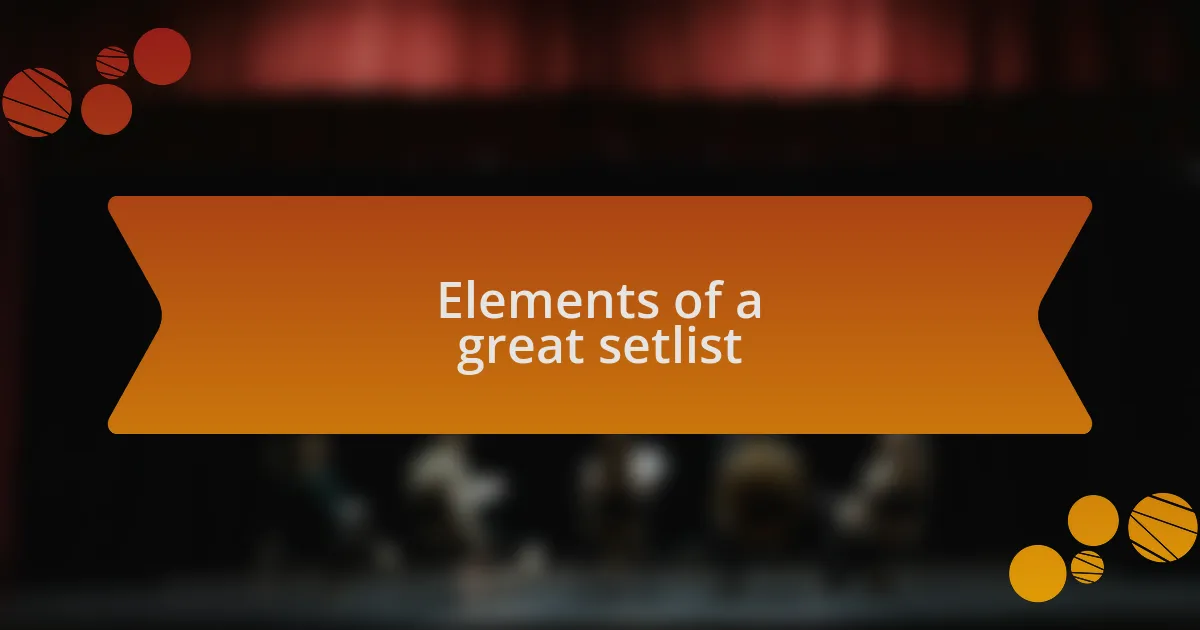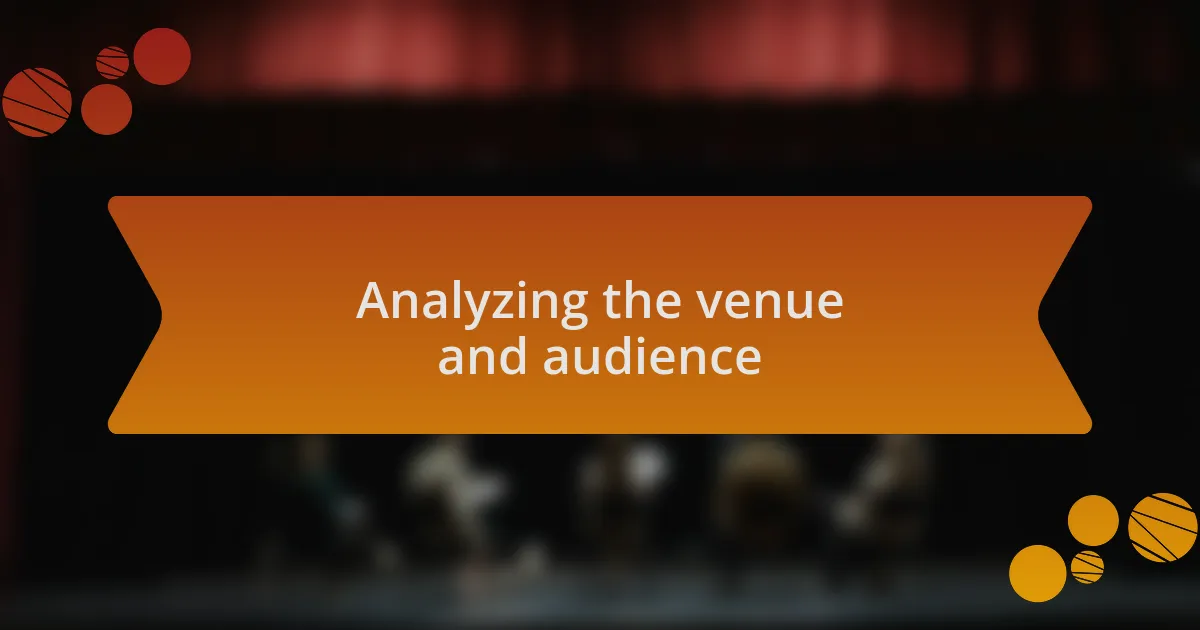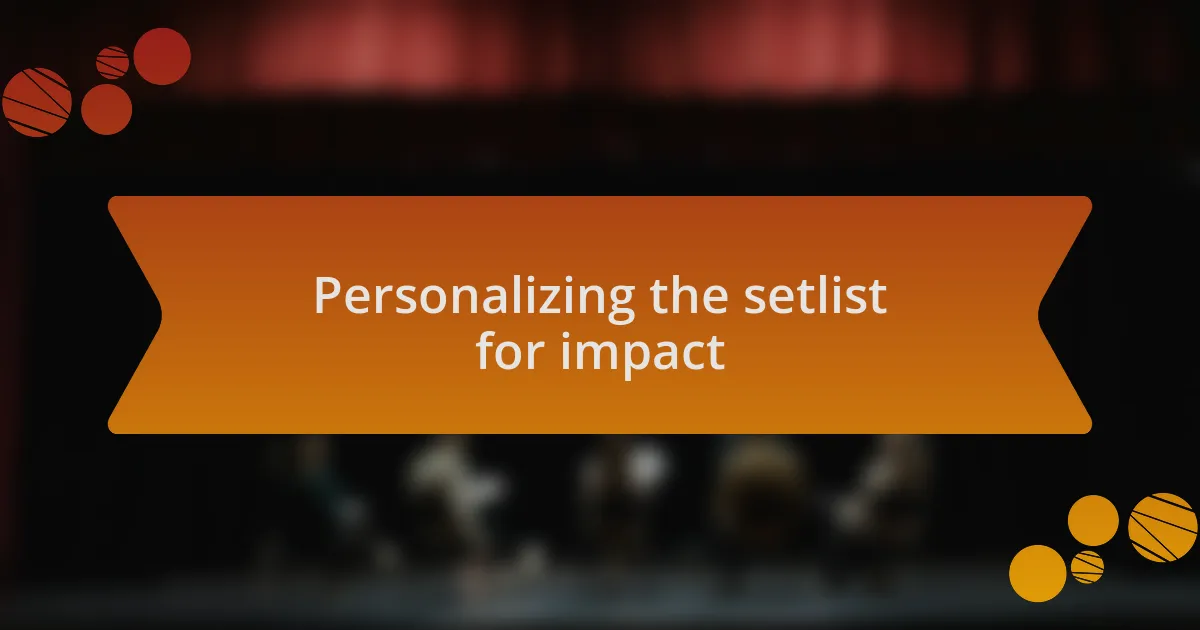Key takeaways:
- A successful nightclub setlist creates a unique experience, balancing different genres and emotional connections to engage the audience.
- Understanding the venue and audience dynamics is crucial for selecting songs that resonate and enhance the overall atmosphere.
- Personalizing the setlist by including local artists and adapting to the crowd’s mood can significantly elevate the performance.
- Testing and refining a setlist through live feedback and spontaneous adjustments can lead to memorable moments and stronger audience connections.

Understanding a nightclub setlist
Creating a nightclub setlist is more than just listing songs; it’s about crafting an experience. I remember a night when I witnessed a DJ carefully selecting tracks to build energy throughout the evening. It made me wonder: how much does the right song choice shape a crowd’s mood?
A successful setlist flows like a narrative, often weaving together different genres and styles to captivate the audience. I’ve seen DJs seamlessly transition from an upbeat electronic track to a nostalgic 90s hit, and the crowd erupted in cheers. It’s moments like these that highlight how thoughtful pacing and variety can turn an ordinary night into an unforgettable one.
Understanding your venue and audience is crucial when developing a setlist. For example, in a more intimate club setting, I have found that playing deeper, melodic tunes can create a different kind of connection. Have you ever noticed how some tracks can evoke feelings of nostalgia or excitement? That’s the power of a well-structured setlist; it resonates on a personal level, making each performance unique to the night.

Importance of a unique setlist
Crafting a unique setlist is essential because it allows an artist to express their identity and artistry. I remember a DJ I knew who always experimented with rare remixes and underground tracks, creating a distinct sound that set him apart from others in the scene. That individuality not only drew devoted fans but also turned each performance into a reflection of who he was as an artist.
A unique setlist can transform the atmosphere of a nightclub, inviting the audience to experience music in a fresh way. I once attended a show where the DJ took an unexpected detour into world music, and it ignited a dance party that transcended language and culture. It made me think—how often do we limit ourselves to mainstream hits when the vast world of music offers so much more?
Moreover, a thoughtfully curated setlist keeps the energy dynamic and unpredictable, ensuring that patrons remain engaged. Have you ever left a club feeling exhilarated because the music felt tailor-made for that moment? That’s the magic of a unique setlist: it creates memorable moments and encourages the audience to return, eager for the next musical adventure.

Elements of a great setlist
An effective setlist harmonizes different musical elements to sustain the audience’s interest throughout the night. I recall a night at a local nightclub when a DJ skillfully transitioned from a high-energy track to a soulful ballad, catching everyone off guard yet keeping the energy alive. It got me thinking about how crucial it is to balance peaks and valleys in the music; it’s all about taking listeners on a journey while maintaining their connection to the vibe.
Tension and release play a vital role in crafting a memorable setlist. I remember dancing to a DJ who built up the crowd with pulsating beats only to drop into a classic, bringing a rush of nostalgia that made everyone cheer. This interplay not only elevates the experience but also reaffirms the idea that music is deeply emotional, often reflecting the highs and lows of our own lives.
Finally, incorporating personal touches, like storytelling through song selection, can make a setlist truly resonate. One DJ I followed often included tracks that held personal significance or anecdotes related to the music—like a favorite road trip song or a tune that reminded him of a past relationship. I still remember the moment he shared the story behind a particular track; it brought a whole new depth to the experience, reminding us all that music is as much about connection as it is about rhythm.

Analyzing the venue and audience
When assessing a venue, I always look closely at its layout and ambiance. For example, I once played at a club with an open layout that encouraged movement, making it easier for people to connect with each other and the music. This experience highlighted how a venue’s physical space can either enhance or limit the audience’s immersion in the music.
Understanding the audience is equally important. During a gig at a smaller venue, I noticed that the crowd felt different from larger events; they were more engaged and responsive to the energy in the room. It struck me how essential it is to read the audience’s vibe—like knowing when to lift them higher with an upbeat track or bring them down with a more introspective piece.
I often think about how demographics influence the musical choices we make. At a recent event, the mix of ages and backgrounds in the crowd reminded me that not everyone shares the same musical history. In moments like this, I’ve found that blending familiar classics with contemporary hits bridges generational gaps, allowing everyone to share in the moment. Isn’t it fascinating how music can span across ages and create shared experiences like nothing else?

Strategies for song selection
When it comes to song selection, I always start by curating tracks that resonate with the vibe of the specific night. One time, I opted for a mix of upbeat indie tracks and nostalgic pop at a rooftop venue, and the energy in the crowd was electric. The songs united us, creating a shared story that flowed effortlessly throughout the night. Isn’t it incredible how a carefully chosen track can transform a moment?
I also pay attention to the transitions between songs, not just the individual selections themselves. I recall a gig where I had to creatively blend a deep house track into a lively top 40 hit. The way the bass dropped smoothly gave the audience just the right jolt, lifting the atmosphere without missing a beat. How do you think a well-timed transition impacts the overall experience?
Another strategy I find effective is tapping into the emotional currents of the night. I remember a time when I sensed a melancholy mood settling in during a slower set. Instead of plowing ahead with my planned list, I pivoted to songs that resonated with those deeper emotions. It felt like a shared moment of vulnerability, reminding me that sometimes, connecting through music means embracing all the feels. How important do you think emotional connection is in a nightclub setting?

Personalizing the setlist for impact
Personalizing a setlist is all about creating an emotional connection with the audience. I once played at a venue where the crowd was predominantly local, and I made it a point to include tracks from hometown artists. The look of recognition and pride on their faces was priceless. It’s moments like these that illustrate how a personal touch in song selection can elevate the concert experience. How does it feel when a song strikes a chord that connects you to your roots?
Another aspect I focus on is the rhythm of the night. During one performance, I noticed the energy shifting after a high-tempo track. Instead of following up with another banger, I dropped in a poignant, slower song that had become a crowd favorite. The collective sigh that enveloped the room created an intimate atmosphere that made everyone feel seen. Isn’t it fascinating how one song can moments of stillness amid a vibrant night?
I also believe in reading the crowd’s mood in real-time. There’s a time when I sensed an unexpected shift in energy during a set; the crowd’s laughter turned into a more reflective silence. Instead of sticking rigidly to my planned playlist, I quickly adjusted to include more contemplative tunes. It was a refreshing reminder that, even in a bustling nightclub, there’s room for introspection. What do you think it says about us when we allow ourselves to feel deeply, even amidst the dancing?

Testing and refining the setlist
Testing a setlist is much like a fine wine; it requires time to mature and be refined. I remember a night when I tried out a new song that I’d been excited about. The initial buzz among the audience was palpable, but I quickly realized that the energy wasn’t quite right. I didn’t just dismiss the song; instead, I adjusted its placement in the setlist for the next gig, allowing for a smoother transition into the next track. Have you ever experienced that moment when a song doesn’t quite land, but you know it will shine in a different context?
I often invite feedback after my shows, using social media to gauge the audience’s favorites. Interestingly, one time, a song I thought was a throwaway became a fan favorite. This revelation led me to experiment more boldly. By pulling audience insights into my testing phase, I can pinpoint which tracks resonate the most and refine my choices for an even tighter setlist. What if the real triumph of a night lies not in the hits but in the hidden gems that the crowd unearths?
Incorporating live testing is crucial. I once added an unexpected mashup midway through a performance, combining two popular tracks. The audience’s reaction was an immediate spike in energy, and I knew then that I had stumbled onto something special. This experience reinforced my belief that a setlist isn’t static; it evolves with each performance. How often do you consider the spontaneous elements that can turn a good night into a memorable one?